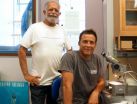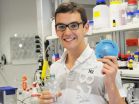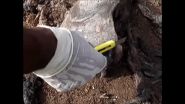(Press-News.org) The drought that has the entire country in its grip is affecting more than the color of people's lawns. It may also be responsible for the proliferation of a heat-loving amoeba commonly found in warm freshwater bodies, such as lakes, rivers and hot springs, which the drought has made warmer than usual this year.
A 9-year-old Kansas girl recently died of an infection caused by this parasite after swimming in several area lakes. The amoeba enters the body through the nose of an individual and travels to the brain. Nose plugs can lower the odds of this rare but fatal pathogen entering the body.
The amoeba, Naegleria fowleri, is classified as a sapronosis, an infectious disease caused by pathogenic microorganisms that inhabit aquatic ecosystems and/or soil rather than a living host. Scientists at UC Santa Barbara studying infectious disease transmission published their findings in the latest issue of the journal Trends in Parasitology.
"Sapronoses do not follow the rules of infectious diseases that are transmitted from host to host," said lead author Armand Kuris, a professor in UCSB's Department of Ecology, Evolution and Marine Biology (EEMB). "They are categorically distinct from the way we think infectious diseases should operate. The paper tries to bring this group of diseases into sharp focus and get people to think more clearly about them."
A well-known example of a sapronosis is Legionnaires' disease, caused by the bacteria Legionella pneumophila, which can be transmitted by aerosolized water and/or contaminated soil. The bacteria can even live in windshield-wiper fluid. Legionnaires' disease acquired its name in July 1976, when an outbreak of pneumonia occurred among people attending an American Legion convention at the Bellevue-Stratford Hotel in Philadelphia. Of the 182 reported cases, mostly men, 29 died.
A major group of emerging diseases, sapronotic pathogens can exist independently in an environmental reservoir like the cooling tower of the Philadelphia hotel's air conditioning system. Some, like the cholera protozoa, rely on mosquitoes to find disease hosts for them. Zoonoses, by contrast, require a human host.
According to Kuris, diseases borne by a vector — a person, animal or microorganism that carries and transmits an infectious pathogen into another living organism — are more or less virulent depending on how efficiently they are transmitted. As a result, virulence evolves to a level where it is balanced with transmission in order to maximize the spread of the virus. However, Kuris noted that there is no virulence trade-off for sapronotic disease agents. Transmission of a sapronosis pathogen is able to persist regardless of any changes in host abundance or transmission rates.
To quantify the differences between sapronoses and conventional infectious diseases, the researchers developed a mathematical model using population growth rates. Of the 150 randomly selected human pathogens examined in this research, one-third turned out to be sapronotic — specifically 28.6 percent of the bacteria, 96.8 percent of the fungi and 12.5 percent of the protozoa.
"The fact that almost all of the fungi we looked at are sapronotic is a noteworthy generalization," Kuris said.
"You can't model a sapronosis like valley fever with classic models for infectious diseases," said co-author Kevin Lafferty, adjunct faculty in EEMB and a marine ecologist with the Western Ecological Research Center of the U.S. Geological Survey. "To combat sapronoses, we need new theories and approaches. Our paper is a start in that direction."
INFORMATION:
Diseases of another kind
In a new paper, UCSB researchers scrutinize a distinctive and prevalent type of infectious agent
2014-07-23
ELSE PRESS RELEASES FROM THIS DATE:
ETH student develops filter for clean water around the world
2014-07-23
Roughly 780 million people around the world have no access to clean drinking water. According to the World Health Organization (WHO), 3.4 million people die from water-related diseases every year. ETH student Jeremy Nussbaumer set himself the goal of making a contribution to solving this problem. Working with researchers from a group led by Wendelin Stark, head of the Functional Materials Laboratory, the 23-year-old spent a year researching a membrane filter and developing a prototype.
"What makes our DrinkPure filter unique is that you can screw it on to virtually any ...
Ketamine can be a wonder drug for ER patients and their physicians
2014-07-23
WASHINGTON -- For critically ill patients arriving at the emergency department, the drug ketamine can safely provide analgesia, sedation and amnesia for rapid, life-saving intubation, despite decades-old studies that suggested it raised intracranial pressure. The results of a systematic review of 10 recent studies of what many emergency physicians regard as a "wonder drug" are published online in Annals of Emergency Medicine "The Effect of Ketamine on Intracranial and Cerebral Perfusion Pressure and Health Outcomes: A Systematic Review."
"Apprehension for many years ...
Climate change and the soil
2014-07-23
Washington, DC -- The planet's soil releases about 60 billion tons of carbon into the atmosphere each year, which is far more than that released by burning fossil fuels. This happens through a process called soil respiration. This enormous release of carbon is balanced by carbon coming into the soil system from falling leaves and other plant matter, as well as by the underground activities of plant roots.
Short-term warming studies have documented that rising temperatures increase the rate of soil respiration. As a result, scientists have worried that global warming ...
AGU: Voyager spacecraft might not have reached interstellar space
2014-07-23
WASHINGTON, D.C. -- In 2012, the Voyager mission team announced that the Voyager 1 spacecraft had passed into interstellar space, traveling further from Earth than any other manmade object.
But, in the nearly two years since that historic announcement, and despite subsequent observations backing it up, uncertainty about whether Voyager 1 really crossed the threshold continues. There are some scientists who say that the spacecraft is still within the heliosphere – the region of space dominated by the Sun and its wind of energetic particles – and has not yet reached the ...
Wide-faced men negotiate nearly $2,200 larger signing bonus
2014-07-23
RIVERSIDE, Calif. -- Having a wider face helps men when they negotiate for themselves but hurts them when they are negotiating in a situation that requires compromise. Additionally, men who are more attractive are better collaborators compared to less attractive men.
Those are among the findings outlined in a just published paper co-authored by Michael P. Haselhuhn and Elaine M. Wong, assistant professors of management at the University of California, Riverside's School of Business Administration. The paper describes four negotiation simulations set up by the authors ...
This week from AGU: Oso report, rockfall in Yosemite Park, and a new ear
2014-07-23
From AGU's blogs: Oso disaster had its roots in earlier landslides
A research team tasked with being some of the first scientists and engineers to evaluate extreme events has issued its findings on disastrous Oso, Washington, landslide. The report studies the conditions and causes related to the March 22 mudslide that killed 43 people and destroyed the Steelhead Haven neighborhood in Oso, Washington. The team from the Geotechnical Extreme Events Reconnaissance (GEER) Association, funded by the National Science Foundation, determined that intense rainfall in the three ...
Protein evolution follows a modular principle
2014-07-23
This news release is available in German.
Proteins impart shape and stability to cells, drive metabolic processes and transmit signals. To perform these manifold tasks, they fold into complex three-dimensional shapes. Scientists at the Max Planck Institute for Developmental Biology in Tübingen have now discovered that proteins can be constructed of similar amino acid chains even when their three-dimensional shapes differ significantly. This suggests that the proteins that exist today arose from common precursors. Presumably, in the course of evolution they were ...
Dead body feeding larvae useful in forensic investigations
2014-07-23
VIDEO:
This image depicts Chrysomya megacephala larvae on decomposing fish.
Click here for more information.
Non-biting blow fly Chrysomya megacephala is commonly found in dead bodies and is used in forensic investigations to determine the time of death, referred to as the post mortem interval. A report of synanthropic derived form of C. megacephala from Tamil Nadu is provided for the first time based on morphological features and molecular characterization through generation ...
Study provides new perspectives on the current Clostridium difficile epidemic
2014-07-23
PASADENA, Calif., July 23, 2014 — More than 80 percent of hospitalized patients who tested positive for Clostridium difficile were tested outside the hospital or within the first 72 hours of hospitalization, suggesting that settings outside of the hospital may play key roles in the identification, onset and possible transmission of the disease, according to a new Kaiser Permanente study published today in the journal Mayo Clinic Proceedings.
The study provides new insight into the contagious and potentially deadly infection also known as C. diff, a bacterium most often ...
Nano-sized chip "sniffs out" explosives far better than trained dogs
2014-07-23
Security forces worldwide rely on sophisticated equipment, trained personnel, and detection dogs to safeguard airports and other public areas against terrorist attacks. A revolutionary new electronic chip with nano-sized chemical sensors is about to make their job much easier.
The groundbreaking nanotechnology-inspired sensor, devised by Prof. Fernando Patolsky of Tel Aviv University 's School of Chemistry and Center for Nanoscience and Nanotechnology, and developed by the Herzliya company Tracense, picks up the scent of explosives molecules better than a detection dog's ...
LAST 30 PRESS RELEASES:
Heart-brain connection: international study reveals the role of the vagus nerve in keeping the heart young
Researchers identify Rb1 as a predictive biomarker for a new therapeutic strategy in some breast cancers
Survey reveals ethical gaps slowing AI adoption in pediatric surgery
Stimulant ADHD medications work differently than thought
AI overestimates how smart people are, according to HSE economists
HSE researchers create genome-wide map of quadruplexes
Scientists boost cell "powerhouses" to burn more calories
Automatic label checking: The missing step in making reliable medical AI
Low daily alcohol intake linked to 50% heightened mouth cancer risk in India
American Meteorological Society announces Rick Spinrad as 2026 President-Elect
Biomass-based carbon capture spotlighted in newly released global climate webinar recording
Illuminating invisible nano pollutants: advanced bioimaging tracks the full journey of emerging nanoscale contaminants in living systems
How does age affect recovery from spinal cord injury?
Novel AI tool offers prognosis for patients with head and neck cancer
Fathers’ microplastic exposure tied to their children’s metabolic problems
Research validates laboratory model for studying high-grade serous ovarian cancer
SIR 2026 delivers transformative breakthroughs in minimally invasive medicine to improve patient care
Stem Cell Reports most downloaded papers of 2025 highlight the breadth and impact of stem cell research
Oxford-led study estimates NHS spends around 3% of its primary and secondary care budget on the health impacts of heat and cold in England
A researcher’s long quest leads to a smart composite breakthrough
Urban wild bees act as “microbial sensors” of city health.
New study finds where you live affects recovery after a hip fracture
Forecasting the impact of fully automated vehicle adoption on US road traffic injuries
Alcohol-related hospitalizations from 2016 to 2022
Semaglutide and hospitalizations in patients with obesity and established cardiovascular disease
Researchers ‘listen in’ to embryo-mother interactions during implantation using a culture system replicating the womb lining
How changing your diet could help save the world
How to make AI truly scalable and reliable for real-time traffic assignment?
Beyond fragmented markets: A new framework for efficient and stable ride-pooling
Can shape priors make road perception more reliable for autonomous driving?
[Press-News.org] Diseases of another kindIn a new paper, UCSB researchers scrutinize a distinctive and prevalent type of infectious agent




